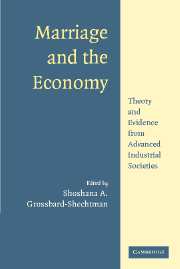Book contents
- Frontmatter
- Contents
- List of Figures
- List of Tables
- List of Contributors
- Foreword
- Acknowledgments
- Marriage and the Economy
- 1 Marriage and the Economy
- PART I THE ECONOMICS OF MARRIAGE AND DIVORCE
- PART II EFFECTS OF MARRIAGE ON INCOME USES
- PART III EFFECTS OF MARRIAGE ON TIME USES
- 9 Marriage, Household Production, and Earnings
- 10 Marriage and Work for Pay
- 11 Marriage, Work for Pay, and Childcare
- 12 Marriage and Home-Based Paid Employment
- PART IV MARRIAGE AND THE MACROECONOMY
- Index
11 - Marriage, Work for Pay, and Childcare
Published online by Cambridge University Press: 07 December 2009
- Frontmatter
- Contents
- List of Figures
- List of Tables
- List of Contributors
- Foreword
- Acknowledgments
- Marriage and the Economy
- 1 Marriage and the Economy
- PART I THE ECONOMICS OF MARRIAGE AND DIVORCE
- PART II EFFECTS OF MARRIAGE ON INCOME USES
- PART III EFFECTS OF MARRIAGE ON TIME USES
- 9 Marriage, Household Production, and Earnings
- 10 Marriage and Work for Pay
- 11 Marriage, Work for Pay, and Childcare
- 12 Marriage and Home-Based Paid Employment
- PART IV MARRIAGE AND THE MACROECONOMY
- Index
Summary
On the most superficial level, the relationship between childcare and marriage is clear. Because married people are more likely to have young children than unmarried people, the former confront childcare issues more often than the latter. Furthermore, single parents typically do not have available a partner's income to permit stay-at-home parenting. Childcare choices for married versus unmarried individuals also vary in less tautological ways. In this chapter, we limit our analysis to a comparison of the childcare choices of married couples and unmarried women with young children, two populations differing in marital status and facing comparable childcare choices. The mere presence of young children in a household creates the need to make a set of decisions – including the use of parental versus non-parental childcare and paid versus unpaid childcare – as well as related decisions concerning employment.
A substantial literature exists on the economics of childcare, though most of the studies are quite recent. The first economic analysis explicitly on childcare was James J. Heckman's 1974 study. He and many authors since then took the importance of marital status for granted to the extent that they only considered the childcare choices of married women. For example, see Evelyn Lehrer (1983); David M. Blau and Philip K. Robins (1988); Rachel Connelly (1992a); David Ribar (1992, 1995); Susan H. Averett et al. (1997); Lisa Powell (1997, 1998, 2002); Charles Michalopoulos and Robins (2000a). The papers that have included single mothers have done so in a variety of ways.
- Type
- Chapter
- Information
- Marriage and the EconomyTheory and Evidence from Advanced Industrial Societies, pp. 248 - 270Publisher: Cambridge University PressPrint publication year: 2003



